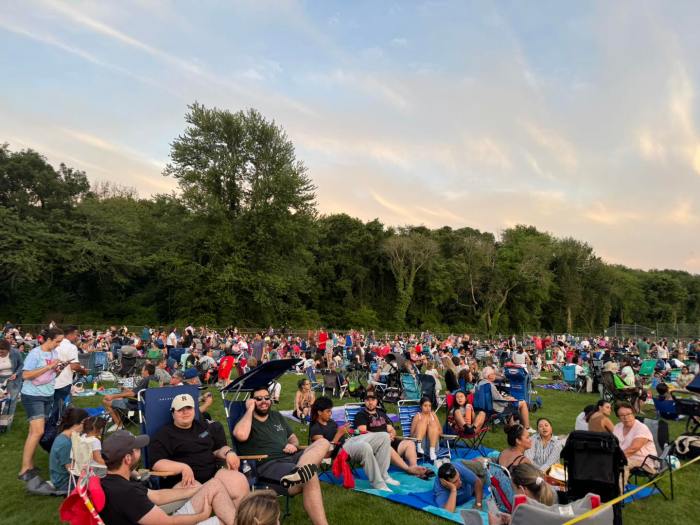Previous articles have highlighted several mansions built by Jones and Floyd-Jones Family members. Tryon Hall (later the Fort Neck House) was the first, built in 1770.
Later on came Massapequa Manor (1837), Sedgmoor (1853) and Holland House (c. 1890). These mansions and the two highlighted below show how the area around Merrick Road was a family stronghold, even as the northern parts of the Massapequas (the Farm District and Massapequa Park north of the railroad) developed in the 1860s.
A map dating from around 1900 in the possession of the Delancey Floyd-Jones Free Library shows how extensive the Floyd-Jones holdings were. William Floyd-Jones, who succeeded to ownership of Massapequa Manor, owned land down to Oyster Bay labeled Fort Neck Meadows. That area is Harbor Green and Biltmore Shores today, extending from Park Boulevard (then called Wurttenburg Road) west to the Massapequa River and down to the water line. John D. Jones owned most of today’s Massapequa Park, as far north as the Southern State Parkway, while his wife’s name is shown as the owner of a parcel that extends to South Oyster Bay near Pirate’s Cove. They and other family sold or rented parcels to farmers and, after 1900, to land developers, enhancing their wealth and status.
Tucked in just south of Merrick Road and west of Park Boulevard was Elbert Floyd-Jones’ estate, unnamed, built in 1870 on land he purchased from his brother William.

The building was dark and somewhat foreboding and rested on a small piece of property. We know more about Elbert than about his estate. Born in 1817, he served several terms in the New York State Assembly and directed the construction of Old Grace Church in 1844. He died in 1901 and his fourth wife, Elizabeth, lived in the mansion until her death in 1916. The house burned down in 1926, apparently from a fireworks accident. Its contemporary connection is that the servants’ cottage behind the house was moved in 1986 from its site next to the Bar Harbour Public Library, to property east of Old Grace Cemetery and is today part of Massapequa’s Historic Complex.
Lieutenant Governor David Richard Floyd-Jones owned the Fort Neck House in the late 1800s, with property that extended down to South Oyster Bay and north as far as Regis Drive. He, like many other large landowners, maintained a cemetery for deceased family members behind his house. Their remains were moved in 1892 to the Floyd-Jones Cemetery behind Old Grace Church, which became the central repository for Floyd-Jones family members, as well as for Thomas Jones, his wife Freelove and two of their children. Their remains were moved from the family plot south of Merrick Road next to Massapequa Creek.
George Stanton Floyd-Jones, David Richard’s eldest surviving son, was given a plot of land east of the Fort Neck House. He built Sewan (the Native American term for “shell beads”), which many observers consider the most attractive of the family mansions. It had a bright and cheerful look, facing Merrick Road and fronted by a large landscaped yard adorned with flowers on all sides. It was the first house in the Massapequas to have indoor plumbing.
George Stanton became very successful in the insurance business, working his way to the Presidency of the Atlantic Mutual Insurance Company. He was heavily involved in local issues, financing the construction of a large Victorian train station in 1890, to replace the small, plain building that was erected by the railroad in 1886. He felt Massapequa deserved a station befitting its stature. The station lasted until 1953, when the Babylon branch was elevated at Massapequa.
Floyd-Jones later became involved in discussions that led to the creation of the Massapequa Water District. Local residents had petitioned the Town of Oyster Bay in 1927 to create a separate water district to serve the growing population. He opposed the additional tax that would be imposed, wondering why he should pay for water that he was currently pumping from his own wells. His situation was clearly unique because new residents didn’t possess the money or equipment to locate and/or pump ground water.
After several meetings with Floyd-Jones and other local representatives, in 1930, the town decided to create a water district with the responsibility to develop a piping and storage system that would provide water throughout the area. Town officials respected Mr. Floyd-Jones’s concerns by exempting him and other large landowners in the southeastern part of the Massapequas from joining the district. Later homeowners who were unable and unwilling to pump their own water contracted with the American Water Works Company (now known as New York American Water) to provide water service.
George Stanton Floyd-Jones and his wife became Roman Catholics in 1894, breaking with the Episcopalianism of their family members. Toward the end of his life (he died in 1941), he gave Sewan to the Dominican Sisters, who used it as their residence, and ran it as Queen of the Rosary Academy from 1948 until 1952. The building and grounds were then bought by the school district, torn down and replaced by Massapequa High School. A building that services hundreds of students replaced one that was built for a single family, another fine example of Massapequa’s post-war population growth.



































